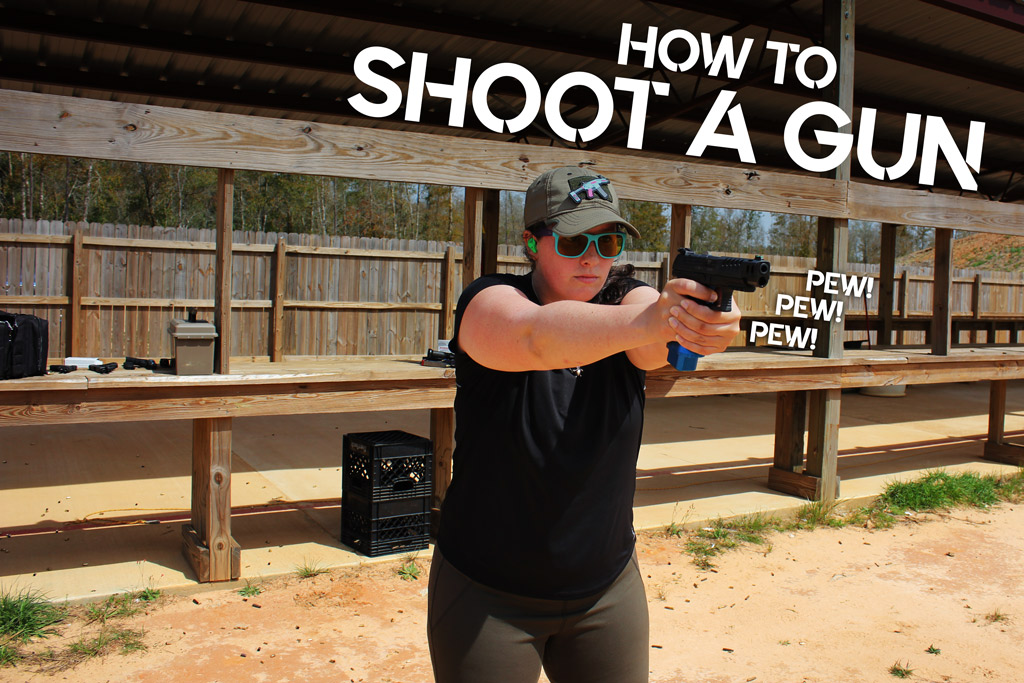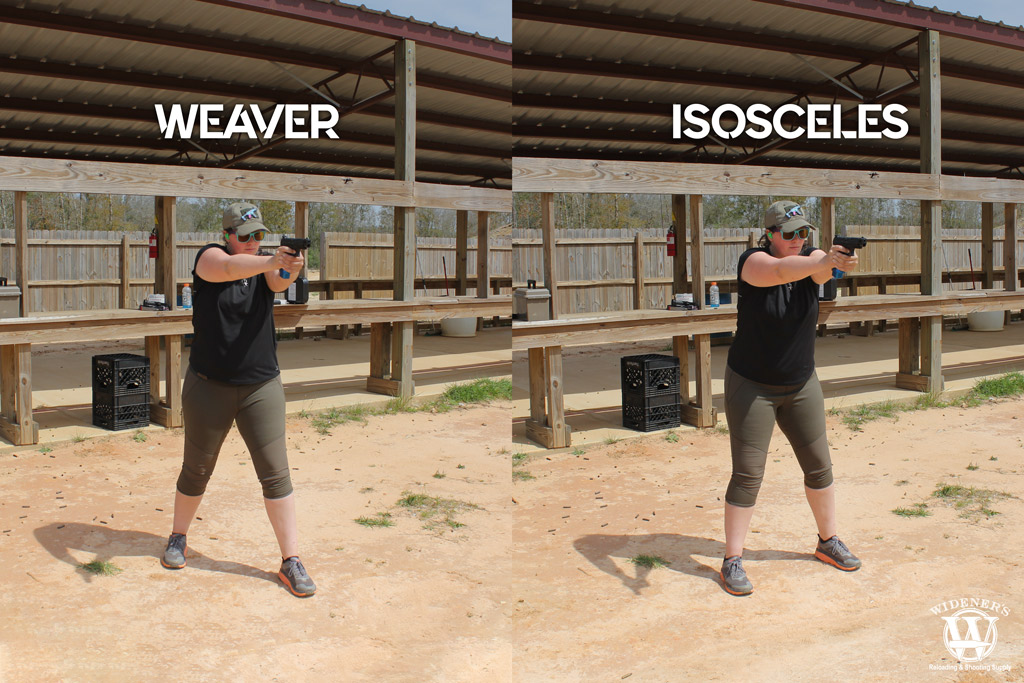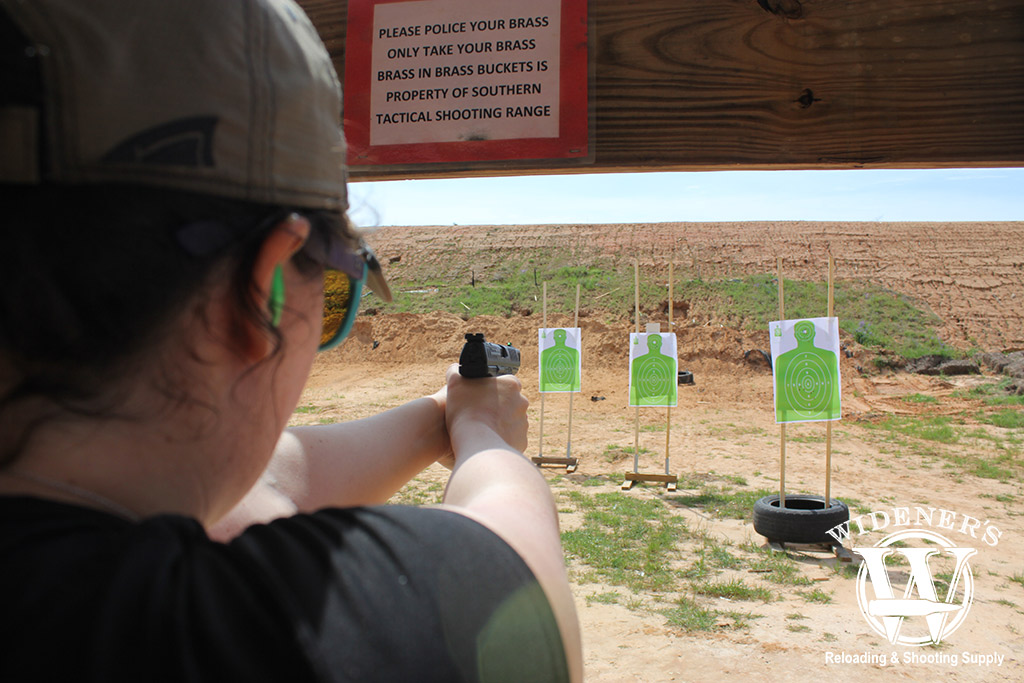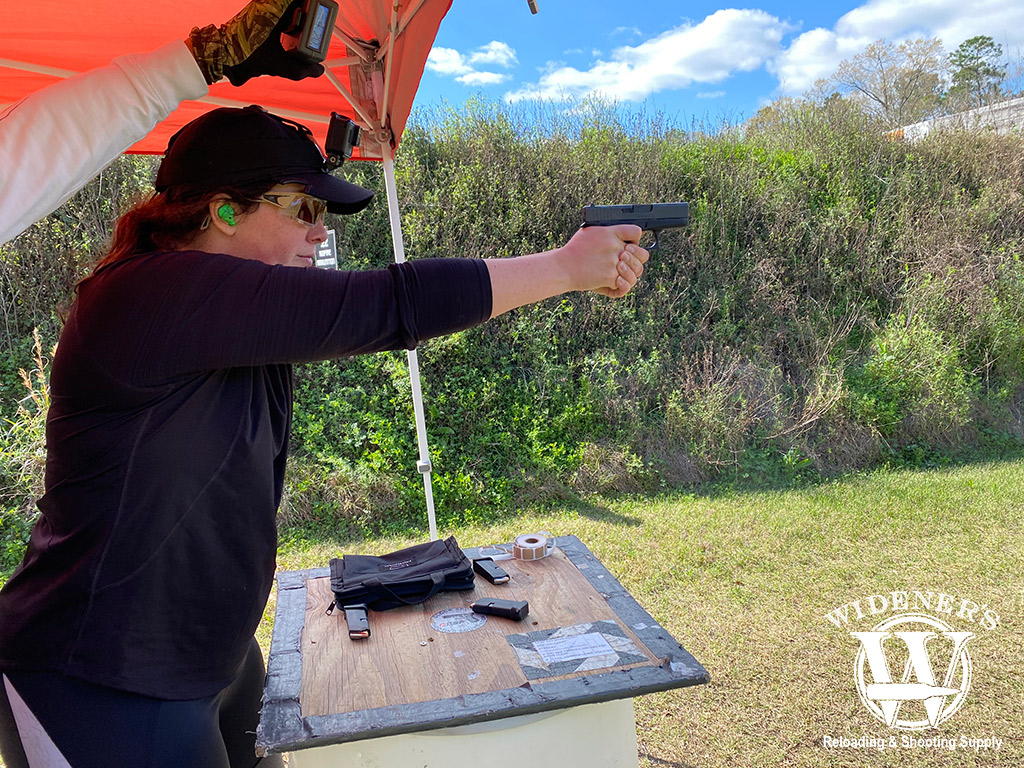

Guest Writer: Kenzie Fitzpatrick
Fundamentals are the key to learning how to shoot a gun. Once you understand the basics of shooting and safety, you can apply them from one gun to the next. Whether you’re the newest shooter out there or a seasoned operator, mastering the fundamentals will get you shooting accurately. When you’ve learned how to shoot a gun using fundamentals, practicing every step every time you shoot, without having to think about it, is how you make progress.
Shooting Fundamentals
Follow these fundamentals each time you pick up a gun and you’ll be hitting the bullseye in no time.
Choose A Stance

The classic Weaver or the modern Isosceles? Both stances have their benefits, so why not try both?
Your shooting stance should be comfortable but serve a purpose. The two most popular shooting stances are Isosceles and Weaver. An Isosceles stance is exactly what it sounds like, making a triangle with your body. Your feet should be set shoulder-width apart with your arms extended straight out in front of you holding the gun.
A Weaver stance sets your strong-side leg rearward and your support side leg forward. Your non-dominant hand is your support hand. Use it to pull the gun backward as your strong hand is pushing the gun forward and straight in front of you.
Whatever stance you choose, it should feel natural and be easy to replicate every time you pick up a gun. Your knees should be slightly bent and you should never lean backward while shooting. When you’re first getting started in shooting, I recommend exaggerating your stance so your upper body is leaning forward behind the gun. If you feel yourself leaning backward at any time, stop shooting, get back into position, and start fresh.
Alignment & Sight Picture

When looking down the sights, the front sight should be in focus and aligned with the rear sights to ensure accuracy.
Sight alignment and sight picture are the two things you are going to work on your entire shooting career. You need both to make the shot. Sight alignment is when the two rear sights are aligned perfectly with the front sight. Because there are so many sight options out there, it’s hard to say “align the three dots” because not every gun is going to have the same sights, but the concept is the same. The front sight should be in between the two rear sights and all three should be the exact same height across.
Sight picture is how you use your aligned sights on a target. The #1 focus on any gun is the front sight. First, you want to see your target and where you are trying to aim, let’s say bullseye. Second, you want to bring the gun up to the bullseye and find the front sight of the gun. That front sight should be set in the middle of the bullseye. Third, align the rear sights with the front sight. Lastly, now that everything is aligned on target, move your focus to your front sight only so that everything else is blurry and pull the trigger.
Trigger Position

Be sure to try out different guns before you buy. If you can’t reach the trigger easily, you may need a different option.
Make sure when you’re first learning how to shoot a gun, that the gun fits your hand. The trigger position is vital to making a good shot. If your finger cannot reach the trigger or can only reach the trigger with the tip of your finger, you won’t be able to make an accurate shot with it.
The best trigger position on a gun is between the tip of your finger and the first knuckle. If you’re able to make this placement on a trigger, the only movement needed to fire a gun is bending this part of your finger backward without anything else moving.
Breath Control
When you pick up a gun, you’ll never be able to keep it perfectly still without bracing it on a stable platform. The gun is never at rest when it’s in your hands. This is why breath control is so important. Never completely hold your breath when shooting a gun. Holding your breath causes fatigue, which in turn causes your hands to be less stable. Your muscles tighten and your heart rate changes, causing more unnecessary hand motion.
Breath control techniques are very hard to master, it’s best to train and figure out what works for you. There are two common techniques you can try. First, try shooting your gun at the end of a long exhale. Your body is very still after you’ve taken a breath and more relaxed after you’ve let it all the way out. Practice this so that your shooting fundamentals and timing are set up so that when you’re at the end of your exhale, you’re ready to pull the trigger.
The second option is to practice shooting at the top of an inhale. Breathe in deeply and fire a shot with your lungs full. You can also try shooting midway through an exhale, or by breathing normally through your shots. As you progress in shooting, learning how to breathe regularly while shooting is the best option especially as your time between shots decreases.
Master The Follow Through
Just like in many sports movements, follow-through is very important when learning how to shoot a gun. The shot doesn’t end after you pull the trigger. Most new shooters will quickly let go of the trigger right after pulling it so they jerk the gun in the process. When you pull the trigger back and the shot is fired, continue the trigger pull to the rear while keeping the sights in alignment on the target. Hold the position steady for about a second after the shot and then assess your target.
What is the target telling you? If your shot is low, you could be flinching before firing the gun, or your sight alignment was off. Is your shot is high? Check to see if the front sight has been set higher than the rear sights. If your shot is to the left or right, your grip or your trigger position could be pulling the gun in a sideways direction. The holes in your target are the data that tell you how to improve your shooting. Assess after every shot and proceed again with all the fundamentals you just learned on how to shoot a gun.
Practice Makes Perfect

Practice makes perfect? At the very least it creates muscle memory, so be sure to correctly use the fundamentals when training to avoid bad habits.
Practicing your fundamentals at home can dramatically improve your live-fire training. When you practice getting into position regularly, your body starts to get into position without a lot of thought or effort. The best part about mastering fundamentals is being able to repeat them behind any gun. Remember to check your position regularly and think through each step so no bad habits are picked up. To practice, you’ll need ammo, be sure to pick up the best deals on practice ammo at Widener’s.
Basic Rules Of Firearm Safety
Remember to always keep in mind the five basic firearms safety rules. Follow these rules when shooting to prevent harm or injury to yourself and others.
- Always keep your firearm pointed in a safe direction.
- Treat all firearms as if they were loaded.
- Keep your finger outside the trigger guard and off the trigger until you are ready to fire.
- Be certain of your target and what lies beyond your target.
- Always wear proper ear and eye protection.


